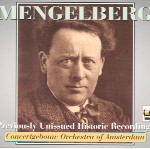Tahra claims these live Mengelberg symphony recordings from 1942 and 1943 to be previously unissued. That’s actually 75 per-cent true. The Beethoven Third, whose 1942 provenance Tahra qualifies with a question mark, strikingly resembles the live Eroica issued by both Music & Arts and Gramofono 2000, but with less distorted sound. Timings are virtually identical, and the recorded balance in both shoves the timpani center stage. I’ll wager that it’s the same performance. Frankly, it adds little to what we ascertain in greater sonic detail from Mengelberg’s 1940 studio Eroica. Likewise, the conductor’s 1943 Beethoven Second and Eighth Symphonies are interpretively similar to the live 1940 versions on Philips. Yet Philips’ closer, cleaner engineering points up the sheer vitality and bite Mengelberg elicits from his well-drilled orchestra. Compare, for example, the stinging entrances in the Second Symphony’s first movement development or the febrile finale to their less characterized 1943 counterparts. Both Eighth Symphonies’ first movements have swooning first movement second subjects and a first-ending ritard that belabors the obvious, big-time. Again, the earlier recording scores for purely sonic reasons. The Brahms First, recorded at the same April 13th 1943 concert as the Beethoven Eighth, suffers from patches of wow, flutter, and distortion. The live 1940 Philips version is more distantly miked, yet is better balanced within each orchestral section. Mengelberg’s frequent tempo gearshifts and sectional ritards may possibly be rooted in delineating structure, yet they tend to grow predictable upon rehearing. Nor am I attracted to the second movement violin soloist’s simpering, maudlin tone. At least the 1943 horn section plays well at the end of the long fourth movement introduction, which was not the case in 1940. In sum, a set that fleshes Mengelberg’s discography, but adds little to what we already know of his conducting these specific works.
































